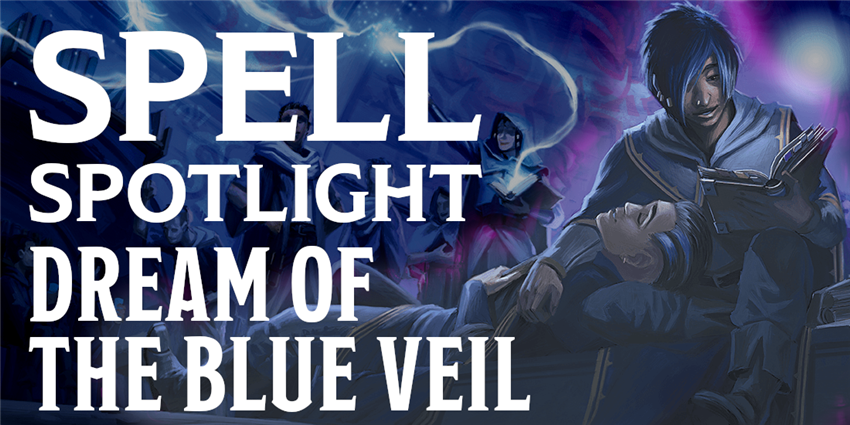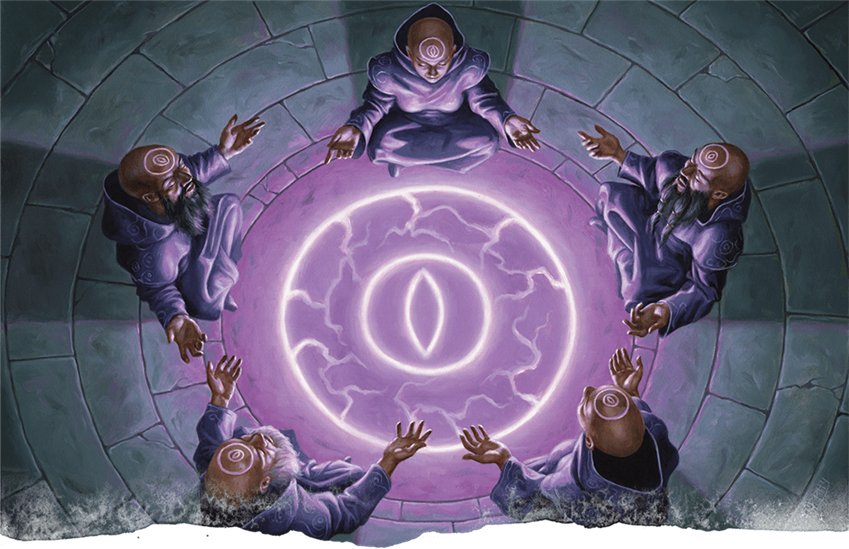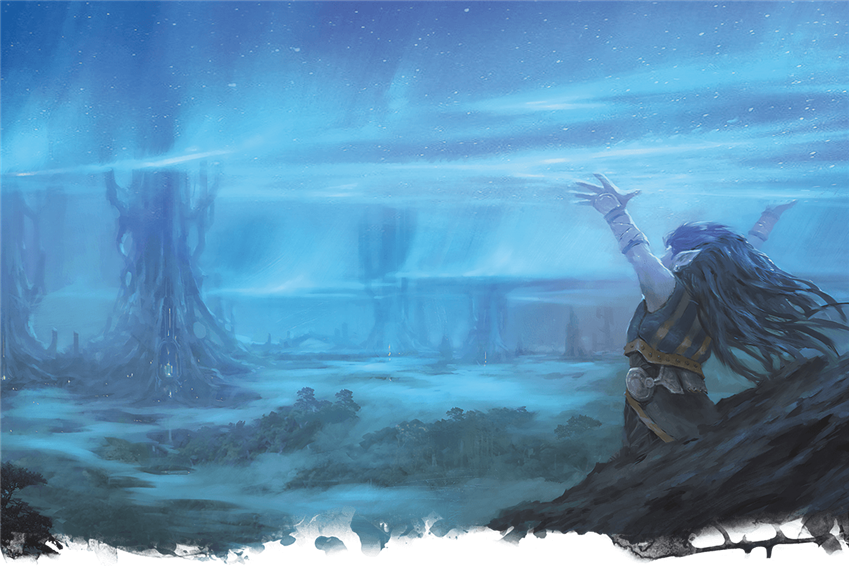Spell Spotlight examines D&D’s best, worst, and most interesting spells, giving you the tools you need to play a spellcaster who knows exactly what they’re doing. Today, we’re looking at a fascinating new spell from Tasha’s Cauldron of Everything that could transform your Dungeons & Dragons campaign: dream of the blue veil. Available to bards, sorcerers, warlocks, and wizards, this is an arcane spell that stands tall in the company of spells like teleport and plane shift. Its applications are straightforward—get from one place to another in the blink of an eye—but the where you wish to go could turn your Dungeon Master’s hair white (not blue) with shock!

For Players: Why Use Dream of the Blue Veil?
The Material Plane holds an infinite number of worlds. Some—like Oerth, Toril, Krynn, and Eberron—are well documented, but there are countless others. You and your friends may even have created some homemade D&D worlds yourselves!
Transit between these worlds is rare but not impossible and can be accomplished in various ways. One such method is […] the Dream of Other Worlds; travelers fall into a deep slumber and dream themselves into a new realm. The spell dream of the blue veil employs this method of transit. […] Whatever method you use to reach a world, the DM determines whether you succeed and where exactly you appear if you do arrive in that realm.
You know what they say: the world is not enough. One world isn’t, anyway. Teleport can take you from place to place on your world, and plane shift can take you to other realities, but the methods of travel between other worlds on the Material Plane aren’t so commonly known. There are several ways, at least one of which can only be accomplished by overcoming a grand and perilous journey—the stuff that epic adventures are made of! If you want your journey between worlds to be a little bit less harrowing, and you have the skill with arcane magic necessary to cast a 7th-level spell, dream of the blue veil is a much faster option, and it’s as easy as counting sheep.
So, why travel between worlds? What does Wildemount offer that Faerûn doesn’t, for example? There are plenty of reasons. You could just want a vacation, of course. I’ve heard that the Menagerie Coast is beautiful this time of year—and the Feolinn wineries are just starting to do their first tastings of the season. Dream of the blue veil is truly the private jet of the magically mighty.
But if you aren’t keen on spending 7th-level spell slots on frivolous endeavors, consider how useful it would be to escape to a realm where no one has ever heard your name. Depending on what world you go to, people may not have even met another person of your race before! A kalashtar wizard who uses the dream to flee the agents of the Dreaming Dark by escaping to Krynn may buy themself enough time to gather new allies, new resources, and return to Eberron with a bold new plan to defeat their enemies.
There may be plot reasons for the characters to seek a way to pierce the veil between worlds—an artifact or an oracle or some other MacGuffin resides on another world—but that’s such a DM-motivated endeavor that it hardly seems worth discussing here in the player-focused side of the article. A more interesting way of doing this sort of plot is to seed it at the very beginning. Perhaps your character is from another world, and on the morning of the first session of the campaign, they awoke in an unfamiliar inn, in an unfamiliar town, in an unfamiliar world. Some fifty sessions later, the party has grown to be heroes known throughout the land and the wizard has some mighty spells at their disposal—and they learn that some MacGuffin is on another world. Your homeworld. Now, your character has a personal connection to the unfolding saga of the dream of the blue veil, especially since…

The Dream’s Material Component: An Easily Overlooked Necessity
Buried at the bottom of the spell description (at least on D&D Beyond’s spell page), is a crucial material component. Do not overlook this. Using this spell requires you to have “a magic item or a willing creature” from the world you wish to travel to using the dream. Since acquiring such an item is entirely dependent upon your Dungeon Master providing the opportunity for such an item or creature to fall into the players’ clutches.
If you’re a player who saw this spell and got a mischievous little glint in your eye, and began dreaming of ways to juke the DM and derail your campaign by suddenly taking a vacation in Eberron from your problems in Faerûn, you’re fresh out of luck. These things work better for everyone when the DM is in on the joke, anyway! Let them know that you want to launch an otherworldly side-story and try to convince them into dropping the skull of a warforged that originated on Eberron into their next dungeon.
For Dungeon Masters: Planning a Multi-World Story
Once your players’ characters reach 13th level—the minimum level needed for a bard, sorcerer, warlock, or wizard to cast dream of the blue veil, a 7th-level spell—you’ll have hopefully played with that party enough to know what kind of adventures they like. It becomes tricky to run pre-published adventures at this high of a level, since your game will likely have become so idiosyncratic that any hardback adventure will need to be retooled significantly to suit your players’ preferences—to say nothing of your own!

So, break out your Dungeon Master’s Guide and start thinking about the power of other worlds. Check out other campaign settings, like Eberron: Rising from the Last War and Explorer’s Guide to Wildemount, and see what sets those worlds apart from others. Or better yet, check out the worldbuilding advice in chapter 1 of the Dungeon Master’s Guide and create your own new world for the party to explore. After all, published campaign settings aren’t the only worlds on the Material Plane. There are countless worlds. Some might be full, Earth-like fantasy settings that require you to do bookloads of worldbuilding, while others might be blasted rocks with only carefully woven spells from a long-dead civilization keeping their thin atmospheres from spiraling out into the great void beyond. A world like this could be planned in an afternoon, and provide enough adventure for a couple sessions’ worth of “dungeon” crawling.
So, why create a story that spans more than one world? One of the best reasons to do so is because you had an old campaign on another world, and now you want to involve retired characters or old NPCs in your current story. That’s a great way to get your old players’ interest!
Creating a worlds-spanning story can also crank up the epic scale of your story, and shift it from heroic fantasy into a more science-fantasy or “sword and planet” genre. This is the approach that D&D’s currently-dormant Spelljammer setting takes, as has the MMORPG World of Warcraft with expansions like The Burning Crusade and Legion. Beloved classic adventure games like The Legend of Zelda: A Link to the Past and Tales of Symphonia use parallel worlds to create a vast story that can draw interesting thematic parallels between one reality and another.
What will you do with the power to create worlds-spanning adventures? Are you a DM or a player—and what will you use this interesting new spell to do in your campaign?
Create A Brand-New Adventurer Acquire New Powers and Adventures Browse All Your D&D Content
 James Haeck is the lead writer for D&D Beyond, the co-author of Waterdeep: Dragon Heist, Baldur's Gate: Descent into Avernus, and the Critical Role Explorer's Guide to Wildemount, a member of the Guild Adepts, and a freelance writer for Wizards of the Coast, the D&D Adventurers League, and other RPG companies. He lives in Seattle, Washington with his fiancée Hannah and their animal companions Mei and Marzipan. You can find him wasting time on Twitter at @jamesjhaeck.
James Haeck is the lead writer for D&D Beyond, the co-author of Waterdeep: Dragon Heist, Baldur's Gate: Descent into Avernus, and the Critical Role Explorer's Guide to Wildemount, a member of the Guild Adepts, and a freelance writer for Wizards of the Coast, the D&D Adventurers League, and other RPG companies. He lives in Seattle, Washington with his fiancée Hannah and their animal companions Mei and Marzipan. You can find him wasting time on Twitter at @jamesjhaeck.











-
View User Profile
-
Send Message
Posted Dec 4, 2020Great article as always James! My d&d group started off playing campaigns in the Forgotten Realms before making our own setting in which to set our new adventures. We still reminisce about those past campaigns though, so having a way to create some crossover between Faerun and our new setting is something we're quite excited for! :)
-
View User Profile
-
Send Message
Posted Dec 4, 2020Can the spell transport creatures to any time/space on the other plane? For example, could you travel to Eberron, stay for a few days, then travel back to Faerun 2000 years after you left?
-
View User Profile
-
Send Message
Posted Dec 4, 2020i love this spell!
3rd
-
View User Profile
-
Send Message
Posted Dec 4, 2020I think the biggest dilemma when using this spell is considering how aware people in your world generally are of other worlds of the material plane. It strikes me as unlikely that the existence of other worlds is common or even rare knowledge, and even if such travel is possible, all but the most magically powerful of mortals would have proof of other worlds of the material plane. I suggest that you only ever allow the use of this spell in a campaign where world-hopping is a major part of the plot: framing it as anything less destroys the infinite possibilities and eldritch experience of traveling to another world. In some settings, You might even rule that other worlds simply can't be accessed.
-
View User Profile
-
Send Message
Posted Dec 4, 2020SO COOL!!!!!!!!!!!!!!!!!!!!!!!!!!!!!!!!!!!!!!!!!!!!!!!!!!!!
5th
-
View User Profile
-
Send Message
Posted Dec 4, 2020to me, the most interesting part of this spell is the fact that if you take any damage in the first 6 hours, the spell fails on you, but not anyone else. if the party has to go through a combat situation right away, what happens? do you avoid it? what if you come across someone in imminent danger? what if one of the Party members dies? do the rest of them power through and do the quest without them, or return to the first world and try again tomorrow? what if waiting is a delay that's to risky? all of these could lead to incredibly fun questions.
-
View User Profile
-
Send Message
Posted Dec 4, 2020Good job James! I might introduce this in my campaign...
-
View User Profile
-
Send Message
Posted Dec 4, 2020" If the spell reaches its full duration, the visions conclude with each of you encountering and pulling back a mysterious blue curtain."
This line here. If the party member takes damage before the conclusion of the six hours you dont get transported anywhere and of course get rudely interrupted in that Long Rest you were having for the spell to be worked.
-
View User Profile
-
Send Message
Posted Dec 4, 2020When you played Magic the Gathering before dnd:
-
View User Profile
-
Send Message
Posted Dec 4, 2020Using wiah to cast this spell eliminates the need for Material Components 😁
-
View User Profile
-
Send Message
Posted Dec 4, 2020Our crew is currently running two different campaigns with two different DMs, alternating play between them each week. Our first idea when we saw Dream of the Blue Veil was as a vehicle to move the characters from the campaign in one DM's world into the world of the other DM.
-
View User Profile
-
Send Message
Posted Dec 4, 2020My big bad evil guy will be an interdimensional conqueror, using this spell cast from wish (so it doesn’t need material components), who was stranded in this world from the stress of wishing, who seeks someone (either an NPC or a PC) to offload the wishing stress onto
-
View User Profile
-
Send Message
Posted Dec 4, 2020Great article! Tasha's has some really neat spells. I bet people have already said these things, but:
Teleport can also bring you across worlds, and you don't need the material component(separate worlds are still on the material plane). I realize that teleport has a failure chance, but there are many situations in which the benefits outweigh the drawbacks.
Even with the material component, you can still annoy your DM. Just make a character from another world. Although that only works if you are doing a 1-off or other thing where you don't have a session zero. Then again, DMs tend to get annoyed at people who annoy them(I know from experience, both as a player and a DM edit: also, that is kind of the definition of annoying someone, making them annoyed at you). And you really don't want your DM annoyed at you(Again, I know from experience). To the DMs out there, I recommend telling the character that their world has been overrun by Tarrasques(or some other legendary monster) and either that there are no safe places, or that "safe" means you have a chance of survival, such as behind a Tarrasque so it doesn't see you when you appear.
-
View User Profile
-
Send Message
Posted Dec 5, 2020Eberron probably shouldn't have been mentioned in the spell as a world you can travel to. According to Rising from the Last War, the Ring of Siberys keeps the Eberron multiverse separate from the rest of the D&D multiverse. So if you tried to use the spell, the default assumption of the Eberron setting is that it would fail. Of course, maybe the Ring of Siberys has a secret hole in it that only you have discovered, or maybe the Ring of Siberys just doesn't function anymore (which would have massive consequences for the rest of the multiverse if the denizens of Xoriat could show up in Faerun, or if Mabar could devour the planes that are part of the Great Wheel as it does Eberron's World Orrery).
In any case, without a Wish, players will have to tell the DM beforehand if they plan to use this spell, and the DM will have plenty of time to decide if that'll be an option. After all, if the characters haven't heard of a particular world, how could they want to go there?
-
View User Profile
-
Send Message
Posted Dec 5, 2020If you're an arcane spellcaster capable of casting 7th level spells, you're by default bound to be aware of the existence of other worlds. They're too integral a part of D&D's cosmology.
-
View User Profile
-
Send Message
Posted Dec 5, 2020Very good story
-
View User Profile
-
Send Message
Posted Dec 5, 2020Reminds of The Smurfs and the Magic Flute... (I'm getting old.)
See 33:30 - 36:00
Although, they might have been traveling to the Feywild.
-
View User Profile
-
Send Message
Posted Dec 5, 2020Your players find a sealed tome called “players handbook” by one C.Perkins it’s even been signed.... let the chaos ensue when they use it as a material component.
-
View User Profile
-
Send Message
Posted Dec 5, 2020Teleport is not limited to the same world, but can take you anywhere on the Prime Material Plane, so this spell is superfluous. It's just WotC's way of telling us we're never getting Spelljammer.
-
View User Profile
-
Send Message
Posted Dec 5, 2020I think I'm going to keep my idea of an icy Stone Age planet in my back pocket in case this spell ever comes up.